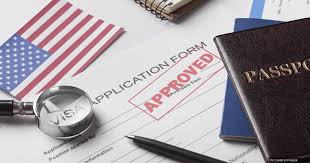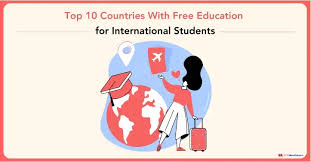USA Student Visa Guide 2025: How to Apply and Get Approved

The United States remains one of the most popular destinations for international students due to its world-class universities, diverse academic programs, and career opportunities. However, obtaining a USA student visa (F-1, J-1, or M-1) can be challenging if you don’t follow the correct process.
This guide will walk you through everything you need to know about applying for a U.S. student visa in 2025, including requirements, application steps, fees, and tips to increase your chances of approval.
Types of U.S. Student Visas
Before applying, it’s important to know which type of student visa you need:
- F-1 Visa (Academic Student Visa)
- For students enrolled in academic programs (universities, colleges, high schools).
- Allows part-time on-campus work (20 hours per week).
- OPT (Optional Practical Training) is available after graduation.
- J-1 Visa (Exchange Visitor Visa)
- For students participating in exchange programs (e.g., Fulbright, cultural exchange programs).
- Requires sponsorship by a U.S. organization.
- Some students must return to their home country for two years after completion.
- M-1 Visa (Vocational Student Visa)
- For students attending vocational or non-academic institutions.
- Work opportunities are limited compared to F-1 visas.
Step-by-Step Guide to Applying for a U.S. Student Visa
Step 1: Get Accepted by a SEVP-Approved Institution
Before you can apply for a student visa, you must be accepted by a Student and Exchange Visitor Program (SEVP)-approved school in the U.S.
- Visit Study in the States to find SEVP-approved schools.
- Apply to your chosen university and receive a Form I-20 (F-1 visa) or DS-2019 (J-1 visa).
Step 2: Pay the SEVIS Fee (I-901)
- After receiving your Form I-20 or DS-2019, you must pay the SEVIS (Student and Exchange Visitor Information System) fee before applying for a visa.
- Fee:
- F-1 visa: $350
- J-1 visa: $220
- Pay online at www.fmjfee.com and print the receipt.
Step 3: Complete the DS-160 Visa Application Form
- Fill out the DS-160 form online at ceac.state.gov
- Upload a passport-sized photo (2×2 inches, white background).
- Print and save the DS-160 confirmation page for your visa interview.
Step 4: Pay the Visa Application Fee
- The non-refundable visa application fee is $185 (as of 2025).
- Payment can be made online through the U.S. embassy website in your country.
Step 5: Schedule a Visa Interview
- Schedule an appointment at the U.S. embassy or consulate in your country.
- Wait times vary, so book early (Check wait times at travel.state.gov).
Step 6: Attend the Visa Interview
At the interview, you must provide:
✅ Valid Passport (Must be valid for at least 6 months beyond your stay).
✅ Form I-20 or DS-2019 (Issued by your school).
✅ DS-160 Confirmation Page.
✅ SEVIS Fee Payment Receipt.
✅ Visa Appointment Confirmation Letter.
✅ Proof of Financial Support (Bank statements, scholarship letters, sponsorship proof).
✅ Academic Transcripts & Test Scores (TOEFL, IELTS, SAT, GRE, GMAT, etc.).
✅ Statement of Purpose (Why you want to study in the U.S.).
Step 7: Visa Approval & Processing Time
- If approved, your passport will be stamped with the F-1, J-1, or M-1 visa.
- Processing time varies (from a few days to several weeks).
- You may be required to pay a visa issuance fee, depending on your country.
Financial Requirements for a U.S. Student Visa
To get a U.S. student visa, you must prove you can afford your tuition and living expenses. Acceptable financial proof includes:
- Bank statements (showing funds for at least one year of study).
- Scholarship or grant confirmation letters.
- Sponsor letters (from parents, guardians, or organizations).
Common Reasons for U.S. Student Visa Denial
- Insufficient Financial Proof – You must demonstrate that you can afford your education.
- Weak Ties to Your Home Country – You must convince the officer you will return home after graduation.
- Incomplete Documentation – Missing or incorrect documents lead to automatic denial.
- Poor English Skills – If you struggle to communicate, it may raise concerns.
- Unclear Study Plans – Be prepared to explain why you chose your university and program.
How to Increase Your Chances of Visa Approval
✔️ Be Honest: Answer all questions truthfully and confidently.
✔️ Have Strong Home Country Ties: Show reasons you will return home (family, job prospects, assets).
✔️ Show Strong Financial Stability: Provide clear proof of funding.
✔️ Speak Clearly and Confidently: Good communication improves your chances.
✔️ Prepare for Common Questions:
- Why do you want to study in the U.S.?
- Why did you choose this university?
- How will you fund your studies?
- What will you do after graduation?
Frequently Asked Questions (FAQs)
1. Can I work while studying on an F-1 visa?
Yes, F-1 students can work part-time (20 hours per week) on-campus during their studies and full-time during vacations.
2. How long can I stay after graduation?
- F-1 students can stay for 60 days after completing their program.
- You can apply for Optional Practical Training (OPT), allowing you to work for up to 12 months (or 36 months for STEM graduates).
3. Can I bring my family with me on an F-1 visa?
Your spouse and children can apply for an F-2 dependent visa, but they cannot work in the U.S.
4. What happens if my visa is denied?
If denied, you can reapply after addressing the reason for rejection. You don’t need to pay the SEVIS fee again if reapplying within 12 months.
Final Thoughts
Getting a U.S. student visa in 2025 requires careful planning and preparation. By following this step-by-step guide and ensuring you meet all the requirements, you can increase your chances of approval and achieve your dream of studying in the United States.



